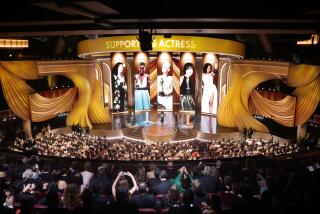Analysis: One year after ‘Moonlight,’ the Oscars still have steps to take toward diversity
At the 2017 Academy Awards, “Moonlight” — against all odds and the unfortunate envelope snafu — triumphed. It was a win many regard as a symbol of progress as Hollywood continues efforts to increase diversity and inclusion both behind and in front of the cameras. But what will Sunday’s Oscars ceremony bring? Times reporters Tre’vell Anderson and Jen Yamato take a look at what to expect on the representation front.
TRE’VELL ANDERSON: We’re finally at the end of a very long awards season, and I can’t wait for it to be over. But the year after “Moonlight,” the Academy Awards are bound to be a hot-button topic. I’m of the belief that they should open the show by re-awarding best picture to Barry Jenkins’ film. Regardless, we’ll be looking at what all might happen in terms of diversity and inclusion on the industry’s biggest night. Where are your eyes going to be?
JEN YAMATO: Has there been a film this year as great as “Moonlight”? It’s certainly a diverse year in terms of the kinds of stories we’re seeing vie for best picture: An obnoxious white girl coming of age in Sacramento; a sensitive white boy discovering his sexuality in Italy; an African American man literally fighting racism; a woman who loves a fish-man; a man who loves dresses; Chris Nolan doing World War II; Steven Spielberg doing newspapers; Frances McDormand out for justice; and Winston Churchill. No wonder it’s hard to peg a front-runner. Yet the fact remains: Even with major nods for filmmakers of diverse backgrounds, the Oscars are still pretty white. How much do you think that’s changing?
ANDERSON: The more things “change,” the more they stay the same. Notable examples of people of color representation in the nominations pool come in the documentary category where the black male director of “Strong Island,” Yance Ford, is the first openly trans person to have a film nominated, and in foreign-language film where “A Fantastic Woman,” starring Chilean trans actress Daniela Vega, is a possible winner. And “Mudbound” director Dee Rees shares a nomination with Virgil Williams for adapted screenplay, making her the first black woman to be nominated for the award.
YAMATO: I’m hoping Oscar Sunday is at least as exciting as nominations morning was this year, when Greta Gerwig (“Lady Bird”) and Jordan Peele (“Get Out”) scored first time directing nominations and Tiffany Haddish coined the phrase “Kalleluuya” while announcing the most thrilling acting nod of 2018: Daniel Kaluuya, for his sharply navigated work battling his way out of the Sunken Place in Peele’s film. We’ll also see previous winner Octavia Spencer compete for best supporting actress in “The Shape of Water” alongside “Mudbound” breakout Mary J. Blige, who made a unique bit of history with not one, but two Oscar nominations including one for original song, shared with fellow R&B legend Raphael Saadiq and Taura Stinson. What’s the 411, Academy? The 411 is representation.
Complete list of the 2018 Academy Award nominees »
ANDERSON: And queen mother Blige will be performing on the big stage! The original song category is actually probably the most diverse, in an interesting way. You have the “Coco” team of Kristen Anderson-Lopez and Robert Lopez, whose “Remember Me” will be performed by Gael García Bernal, Natalia LaFourcade and Miguel, and the “Marshall” anthem “Stand Up for Something” by Diane Warren and Common, which will be performed by the Oscar-winning rapper alongside songstress Andra Day. And then there’s Sufjan Stevens, who will be performing “Mystery of Love” from the gay love story “Call Me by Your Name,” and “This Is Me” from “The Greatest Showman,” written by Benj Pasek and Justin Paul, who won in this category last year for “La La Land.” “This Is Me” will be performed by actress Keala Settle, who’s in the film. So, at minimum, the singing will be on point and represent a more inclusive space.
Other than that though, diversity at this year’s Oscars isn’t really something to call home about, either on the racial and ethnic front or the female representation front — and I’m obviously speaking of the non-gendered, below-the-line categories here. This reflects what UCLA’s latest Hollywood Diversity Report states, that women and people of color continue to be underrepresented. And don’t get me started on diverse and varied LGBTQ representation or that of disabled folks or other marginalized groups, and I say that for the Academy Awards but more importantly the industry at large.
Three years after #OscarsSoWhite, where exactly are we? And does any of what we’re saying and looking out for matter?
YAMATO: It says that having the continued conversation around inclusion in Hollywood and the films it honors on its most esteemed night of nights is as essential as ever. Keep that hashtag alive, people. We haven’t seen huge change yet, but we are in a moment of progress. That UCLA report on diversity in 2016 films helps to ground the Oscars against reality: Less than 7% of directors of the top 200 films that year were women; people of color represented only 13.9% of lead roles in films. Celebrate the landmarks, even if they’re baby steps toward full and equal consideration for all, but then get back to work. And root for Rachel Morrison, the cinematography branch’s first ever female nominee! It took only 90 years. Her work on “Mudbound” is so sublime, you can smell the earth and the sweat and the fraught human emotions through her photography.
ANDERSON: Couldn’t agree more. And if you haven’t seen “Black Panther,” which is Morrison’s latest project, you’re doing yourself a disservice.
We must also give kudos to Kumail Nanjiani and Emily V. Gordon, who share a writing nomination for “The Big Sick,” a film that hasn’t gotten enough awards season love; Kazuhiro Tsuji, who is nominated, for the third time, this year for the “Darkest Hour” makeup; and Agnès Varda and James Ivory who, at 89, are our oldest nominees this year (and the oldest on record), for the documentary “Faces Places” and adapted screenplay of “Call Me by Your Name,” respectively.
YAMATO: This year we can also expect to see diverse faces onstage at the Oscars. Show producers Michael De Luca and Jennifer Todd have not only tapped presenters from the ranks of former winners and nominees like Mahershala Ali, Nicole Kidman, Rita Moreno and Lupita Nyong’o, but popular favorites like Dave Chappelle, Lin-Manuel Miranda, the great Tiffany Haddish and Mexican star Eugenio Derbez. “Black Panther” star Chadwick Boseman, “Star Wars: The Last Jedi” breakout Kelly Marie Tran and “Wonder Woman” herself, Gal Gadot, all will be presenting at the Oscars after headlining three of Hollywood’s biggest recent hits, both in terms of box office and representation. That’s where the Oscars organization will show that it knows the world is watching — even if the awards themselves have a long way to go to reflect an inclusive Hollywood.

90th Oscars Red Carpet rollout on Hollywood Blvd. (Video by Al Seib/Los Angeles Times)
ANDERSON: But before the academy can do that, the industry itself must actually be inclusive. We need more folks outside of what Hollywood traditionally considers worthy to be given a chance to lead a movie and direct and write and be sound mixers and cinematographers and production and costume designers.
YAMATO: Absolutely. As much as everyone in Hollywood likes to deflect responsibility for putting words into action, the Oscars and the film industry share a symbiotic relationship; one cannot make significant progress against history unless the other moves forward, too. I’m hoping for more transparency in the conversation around representation at this year’s ceremony now that people — especially famous celebrities and filmmakers — have been emboldened to speak out for those who aren’t in the room, and for those who have never even been given the chance to knock on the door to get into the room. Maybe then the 91st year will be the charm.
More to Read
Only good movies
Get the Indie Focus newsletter, Mark Olsen's weekly guide to the world of cinema.
You may occasionally receive promotional content from the Los Angeles Times.












